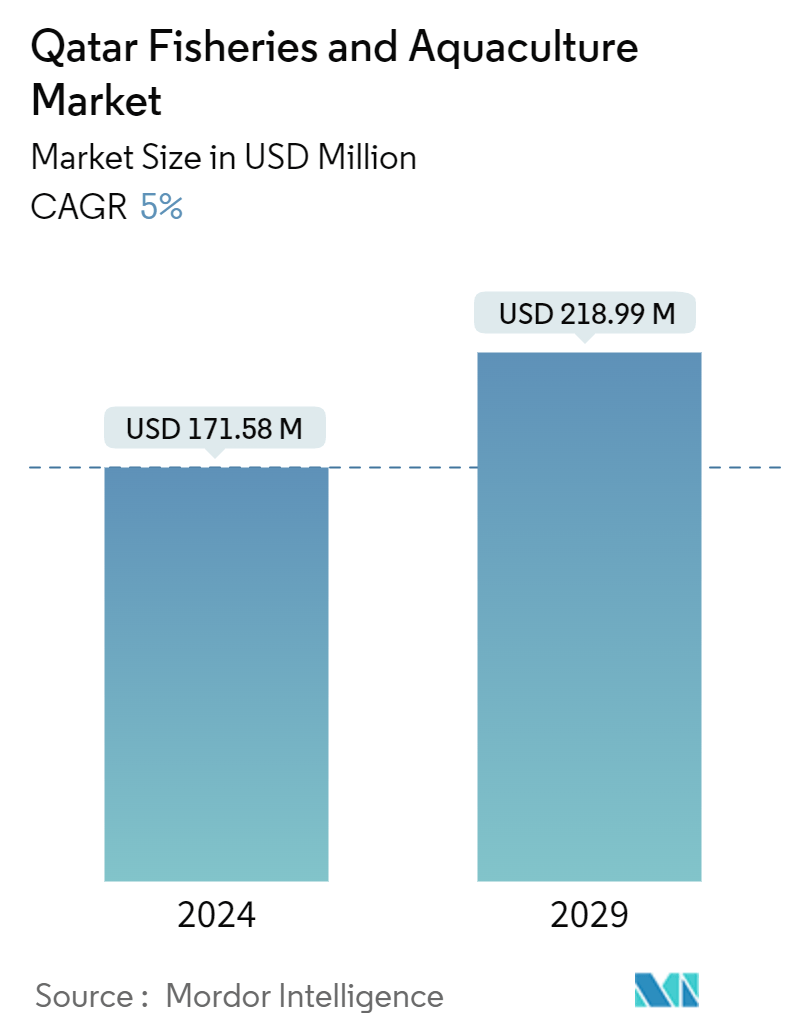Market Size of Qatar Fisheries And Aquaculture Industry

| Study Period | 2019 - 2029 |
| Base Year For Estimation | 2023 |
| Forecast Data Period | 2024 - 2029 |
| Market Size (2024) | USD 171.58 Million |
| Market Size (2029) | USD 218.99 Million |
| CAGR (2024 - 2029) | 5.00 % |
Qatar Aquaculture Market Analysis
The Qatar Fisheries And Aquaculture Market size is estimated at USD 171.58 million in 2024, and is expected to reach USD 218.99 million by 2029, at a CAGR of 5% during the forecast period (2024-2029).
- Qatar has the potential to be a world leader in marine salt-based aquaculture, which is possible with research and exploration of its natural water resources. The Qatari fisheries sector for the country is important from a socio-economic viewpoint. In many coastal communities, the sector enables economic activity and employment opportunities.
- Aquaculture is not a traditional activity in Qatar, as there is little aquaculture production. The existing aquaculture activities have been conducted by researchers in small-scale freshwater facilities, using tilapia. The major fish market in Qatar is in Doha. However, smaller markets exist at Al-Shamal, al-Wakra, and al-Khour. Most of the produce is consumed locally, although some fish are exported to neighboring countries, particularly Saudi Arabia.
- Over the long term, the fisheries and aquaculture market in Qatar is estimated to grow steadily as people shift toward foods rich in protein sources. According to the United Nations Food and Agricultural Organization, seafood consumption in Qatar has risen to 24.5 kg per year due to increased awareness about the health benefits of consuming fish, which outreaches domestic production. Hence, the government has started initiatives to make Qatar self-sufficient in seafood which increases the production of aquaculture. For instance, in 2022, aquaculture production reached 98 metric tons from 23 metric tons in 2020.
- Due to the pivotal role fisheries and aquaculture play in achieving self-sufficiency and meeting human protein needs, the government is focusing on the development of the industry. The rate of over-exploitation of the species has pushed it to the brink of extinction. To reduce that, the government has launched many projects and schemes to encourage sustainable farming practices. For instance, in 2020, the Qatar government launched the first offshore Aquaculture project in open water using floating cages technology in Qatar and the region.
Qatar Aquaculture Industry Segmentation
Aquaculture is the production of aquatic organisms under controlled conditions throughout part or all of their lifecycle. Qatar's aquaculture industry has been expanding over the past few years. The Qatar Fisheries and Aquaculture Market is segmented by Type (Pelagic Fish [Sardine, Mackerel, Tuna, and Barracuda], Demersal Fish [Grouper, Trevally, Emperor, and Pomfret], Freshwater Fish, Scallop, Shrimp, Lobsters, Caviar and Other Types). The report offers market sizes and forecasts in volume (metric tons) and value (USD) for all the above segments.
| Type | ||||||
| ||||||
| ||||||
| Freshwater Fish | ||||||
| Scallop | ||||||
| Shrimp | ||||||
| Lobsters | ||||||
| Caviar | ||||||
| Other Types |
Qatar Fisheries And Aquaculture Market Size Summary
The Qatar aquaculture market is poised for steady growth over the forecast period, driven by a shift in consumer preferences towards protein-rich foods and increased health consciousness post-pandemic. The demand for fish and other aquaculture species is rising due to their nutritional benefits, including high protein content and omega-rich fatty acids. The Qatari government's initiatives to diversify the economy and promote foreign investment in the fisheries and aquaculture sector are creating new opportunities for growth. Research and development activities, such as the establishment of the Aquatic Research Centre, are further supporting the expansion of the industry. The growing population, booming economy, and status as a tourist destination are increasing the demand for high-quality culinary products, necessitating sustainable management of marine resources.
The fisheries sector in Qatar is critical for achieving food self-sufficiency and reducing import dependency. Strategic investments in fish farming, such as the Samakna project, are enhancing fish production and supporting the country's food security goals. Government-led initiatives, including large-scale fish-growing operations, are contributing to increased fish production. The construction of facilities like the single-cell protein plant and land-based shrimp facility underscores the country's commitment to sustainable aquaculture practices. These efforts are expected to significantly boost the demand for seafood products, aligning with the changing consumer food choices towards a diet high in animal proteins and healthy fats.
Qatar Fisheries And Aquaculture Market Size - Table of Contents
-
1. MARKET DYNAMICS
-
1.1 Market Overview
-
1.2 Market Drivers
-
1.2.1 Increase In Seafood Demand
-
1.2.2 Rising Government Support to Enhance the Sector
-
1.2.3 Rising Import of Seafood as a Result of Increasing Demand
-
-
1.3 Market Restraints
-
1.3.1 Unsustainable Capture Fishing and Lack of Facilities
-
1.3.2 Meteorological And Hydrological Conditions
-
-
1.4 Value Chain/Supply Chain Analysis
-
-
2. MARKET SEGMENTATION
-
2.1 Type
-
2.1.1 Pelagic Fish
-
2.1.1.1 Sardines
-
2.1.1.2 Mackerel
-
2.1.1.3 Tuna
-
2.1.1.4 Barracuda
-
-
2.1.2 Demersal Fish
-
2.1.2.1 Grouper
-
2.1.2.2 Trevally
-
2.1.2.3 Emperor
-
2.1.2.4 Pomfret
-
-
2.1.3 Freshwater Fish
-
2.1.4 Scallop
-
2.1.5 Shrimp
-
2.1.6 Lobsters
-
2.1.7 Caviar
-
2.1.8 Other Types
-
-
Qatar Fisheries And Aquaculture Market Size FAQs
How big is the Qatar Fisheries And Aquaculture Market?
The Qatar Fisheries And Aquaculture Market size is expected to reach USD 171.58 million in 2024 and grow at a CAGR of 5% to reach USD 218.99 million by 2029.
What is the current Qatar Fisheries And Aquaculture Market size?
In 2024, the Qatar Fisheries And Aquaculture Market size is expected to reach USD 171.58 million.

